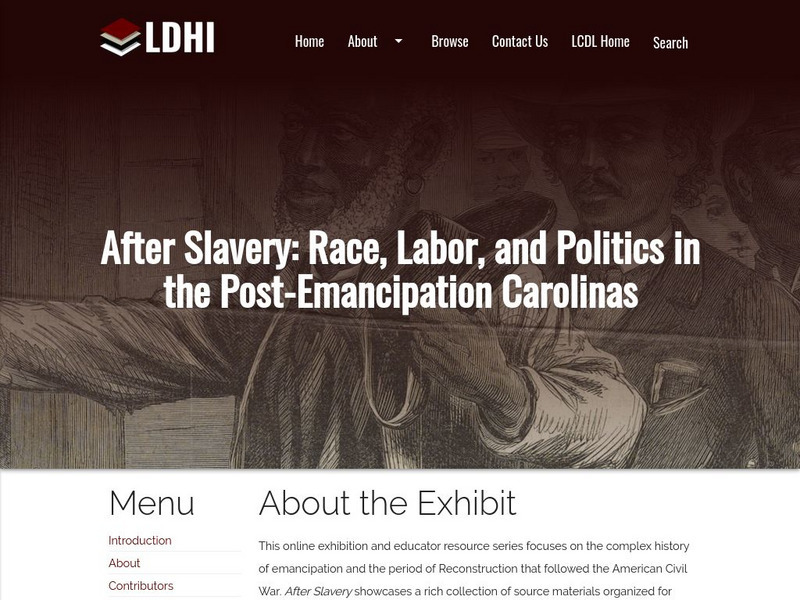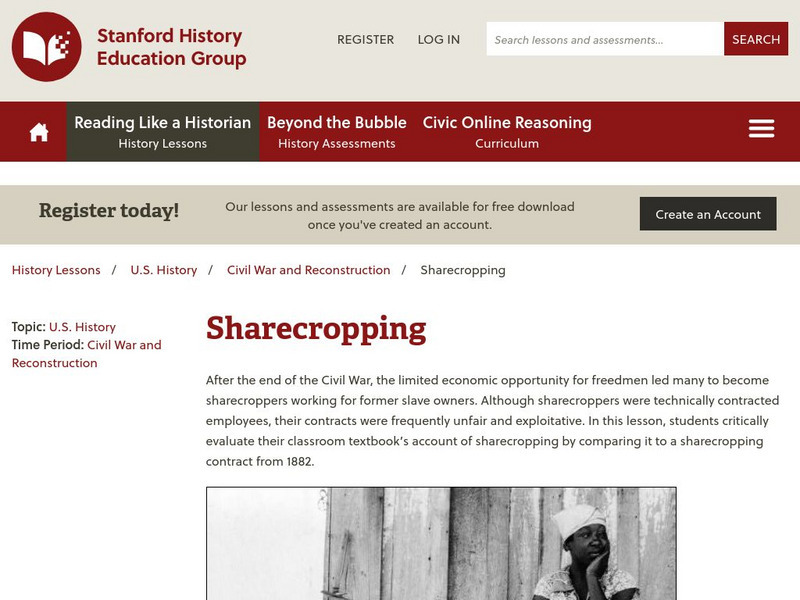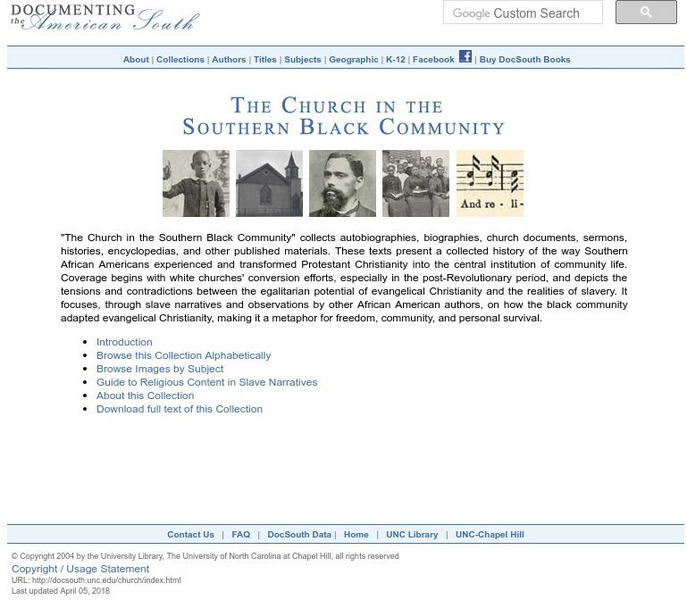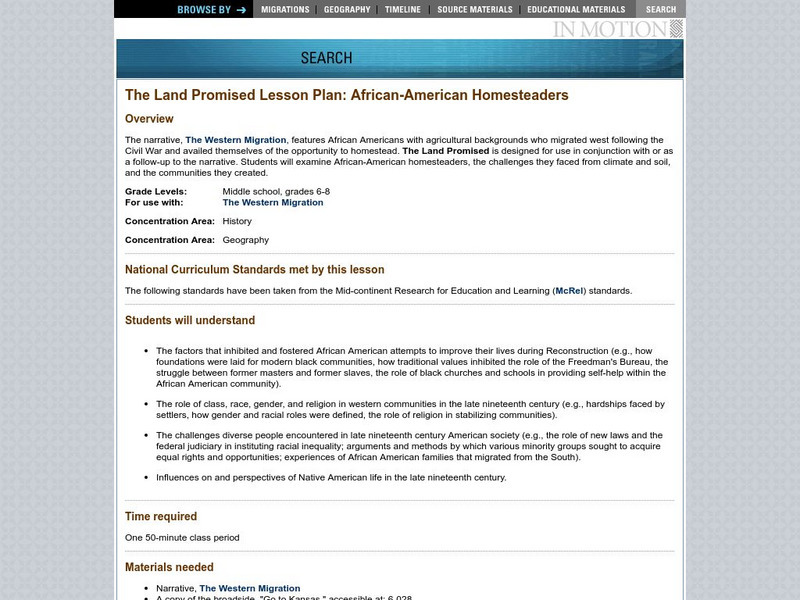National Humanities Center
National Humanities Center: Toolbox Library: Identity, Making of African American Identity: V. 2, 1865 1917
Sixteen primary sources-historical documents, literary texts, visual images, audio, and video material-that explore how African Americans created group and individual identities in the late-nineteenth century.
National Humanities Center
National Humanities Center: Toolbox Library: Freedom, Making of African American Identity: V. 2, 1865 1917
Sixteen primary sources-historical documents, literary texts, visual images, and audio material-that explore African American perceptions of freedom from Emancipation to the early-twentieth century.
Digital History
Digital History: Meaning of Freedom: Black and White Responses to End of Slavery
Confederate defeat and the end of slavery brought far-reaching changes in the lives of all Southerners. The destruction of slavery led inevitably to conflict between blacks seeking to breathe substantive meaning into their freedom by...
National Humanities Center
National Humanities Center: Teacher Serve: Reconstruction and the Formerly Enslaved
What are the "big questions" of Reconstruction? Article provides an overview of the Reconstruction period when Americans debated rights and the nature of freedom and equality. It focuses on who was an American and how citizenship should...
Other
After Slavery Project: Race, Labor and Politics in Post Emancipation Carolinas
This site is a collaborative work-in-progress involving a team of four scholars based in the US, Ireland and the UK. It consists of ten learning units on topics revolving around the emancipation of slaves in the American South following...
US National Archives
Docsteach: From Dred Scott to Civil Rights Act of 1875: Eighteen Years of Change
In 1857, the U.S. Supreme Court ruled in the Dred Scott decision that African-Americans were not citizens of the United States. Yet within 18 years, Black Americans would not only have citizenship, but would be guaranteed the right to...
Stanford University
Sheg: Document Based History: Reading Like a Historian: Sharecropping
[Free Registration/Login Required] Students solve a problem surrounding a historical question by reading primary source documents. This historical inquiry lesson allows students to critically evaluate their classroom textbook's account...
Stanford University
Sheg: Document Based History: Reading Like a Historian: Reconstruction Sac
[Free Registration/Login Required] Young scholars use primary source documents to investigate central historical questions. In this structured academic controversy, students examine constitutional amendments, a Black Code, a personal...
University of North Carolina
Unc: The Church in the Southern Black Community
These historically significant primary documents trace the evolution of the church in the black south into a significant part of the community.
Digital History
Digital History: From Slave Labor to Free Labor
The most difficult task confronting many Southerners during Reconstruction was devising a new system of labor to replace the shattered world of slavery. Learn how plantation owners and freed slaves adapted to this massive shift in the...
National Humanities Center
National Humanities Center: Toolbox Library: Institutions: Power
This sermon by Rev. Alexander Crummell calls for racial solidarity and self-help, forcefully addressing the question of why African Americans should have their own distinctive institutions.
National Humanities Center
National Humanities Center: Toolbox Library: Institutions: Religion, Making of African American Identity
Scholarly article and an address that discuss the role of religion in the shaping of African American identity during the late-nineteenth century.
National Humanities Center
National Humanities Center: Toolbox Library: Freedom: Charles W. Chesnutt: African American Identity
Short story that explores the cultural and linguistic resources that sustained African Americans in the first years of freedom. This resource focuses on Charles Chesnutt and the influence he achieved by writing about race for a white...
National Humanities Center
National Humanities Center: Toolbox Library: Reconstruction: African American Identity: 1865 1917
An interview, government reports, two paintings, and a work song that explore the constraints placed upon African American freedom in the late-nineteenth century as a result of reconstruction.
New York Public Library
In Motion: The Land Promised Lesson Plan: African American Homesteaders
The narrative, The Western Migration, features African Americans with agricultural backgrounds who migrated west following the Civil War and availed themselves of the opportunity to homestead. The Land Promised is designed for use in...
Georgia Humanities Council and the University of Georgia Press.
New Georgia Encyclopedia: Sharecropping
Features a detailed discussion of sharecropping, a labor system that developed in Georgia after the Civil War in which workers raised crops for someone else in exchange for a share of the crop.
Other
Nutrias Online Exhibits: The World of Francois Lacroix
Traces the life of the richest black man in New Orleans before the Civil War and after.
Other
W.e.b. Du Bois: Black Reconstruction in America 1860 1880
In this article, the book Black Reconstruction in America by W.E.B. Du Bois is reviewed by Keeanga-Yamahtta Taylor. This book was written to convey the experiences of African Americans during and after the Civil War, which other history...
Constitutional Rights Foundation
Constitutional Rights Foundation: African Americans and the 15th Amendment
Article on equal rights and the series of events leading to the passage of the 15th Amendment. Includes questions for discussion and an activity in which students re-create the Voting Rights Convention.
University of North Carolina
Documenting the American South: The New Slavery in the South
This autobiography of an African-American man relates his experiences as a free laborer in Georgia after the Civil War. You will see that he felt his conditions were not unlike the slavery that existed before the Civil War. From the...
Khan Academy
Khan Academy: Ap Us History: 1844 1877: Reconstruction: Life After Slavery
Discusses what life was like for African Americans who were freed from slavery after the Civil War. Includes questions for students.
Library of Congress
Loc: African American Odyssey: Reconstruction and Its Aftermath
From the Library of Congress, this resource documents the course of post-Civil War, post-slavery life for black Americans. Topics include education, constitutional amendments, voting rights and the many challenges African Americans faced...
CommonLit
Common Lit: Text Sets: Reconstruction to Jim Crow
After the Civil War and end of slavery, Americans had to decide how to integrate freed African Americans. Learn about the lives of African Americans from Reconstruction to the end of the prejudiced Jim Crow era. This collection includes...
Columbia University
Columbia University: Columbia University & Slavery Post 1865: Students
African American students began to matriculate at Columbia in significant numbers by the 1920s, but they remain all but invisible in the university's archival records. This site highlights several early black students that continued on...























